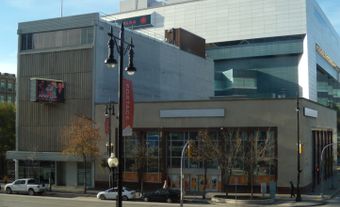Public Relations
Public relations consists of communications initiatives intended to influence favourably attitudes toward a corporation, public body or public figure, in order to promote acceptance of values pertaining to products, policies or concepts of the group or individual. Public relations is widely practised by modern business and governments in Canada.
Public Relations Activities and Techniques
Any communications strategy aimed at influencing an organization and its products, an individual or a concept involves public relations. While some ADVERTISING is a component of public relations, advertising and public-relations functions are usually regarded as separate disciplines.
Early steps in any public-relations campaign are to identify the "public" to whom a message is directed and to devise a strategy to ensure the credibility of the message. The strategy should also establish objectives relative to the various publics and define means to reach these groups. Activities might include community relations, which could provide support for charities or corporate positioning; consumer relations, involving strategies to improve a company's competitive position in the marketplace; government liaison, which may involve LOBBYING public officials and taking steps to win public support; and media relations, for the purpose of gaining increased awareness through publicity.
Public Relations Credibility
The credibility of public relations has occasionally been affected adversely by conscious efforts of some individuals to engage in "public-relations exercises" in an effort to obscure facts or even mislead public opinion. Responsible public relations, however, is concerned with communicating factual information, with full disclosure of sources and open discussion of all aspects of controversial issues.
History of Canadian Public Relations
The contemporary public-relations business can be traced back to advertising, business writing and press-agents' activities in the late 19th century. One of the earliest examples of public relations in Canada - the trans-Atlantic campaign of the Liberal government of Sir Wilfrid Laurier to attract immigrants to the West - actually pre-dates the emergence of recognized PR activity, although it employed tactics which still form the basis of much public-relations practice. More than 2 million newcomers found their way to Canada between 1896 and 1911, attracted by a massive publicity campaign and grants of free land. The campaign, orchestrated by Minister of the Interior Clifford Sifton, saw lecturers tour fall fairs in the US, backed up by thousands of pamphlets and ads in 7000 American newspapers. Six hundred US editors (in an early version of the modern "media tour") were given free trips to Canada, as were British MPs. Agents scoured Britain, Germany and other European countries to publicize the "golden fields" of the West and to lure to Canada city workers and the "peasants in sheepskin coats" whom Sifton proclaimed were the "good quality" settlers needed to fill the Canadian North-West. While public relations was unknown in a commercial sense at the time, Sifton's campaign stands as a model in communications, targeted to specific audiences, and it probably represents the greatest and most successful public-relations campaign in Canadian history.
Since WWII the growth of public relations has mirrored the growth of the Canadian economy. The field sees its greatest growth in the future, as private corporations and public institutions find themselves under increasing scrutiny from a skeptical public.
In 1948 the Canadian Public Relations society was formed in Montréal and the Public Relations Association of Ontario in Toronto. The groups merged in 1953 as the Canadian Public Relations Society (CPRS), which was incorporated by federal charter on 17 April 1957. By the mid-1960s the growth of public relations in Canada as a para-profession led CPRS to introduce a voluntary accreditation program in 1969. Successful applicants are designated APR (Accredited, Public Relations), which indicates that a practitioner has worked full-time in public relations for at least 5 years, has completed a 3-part examination, and has agreed to abide by the society's Code of Professional Standards. By the late 1990s there were more than 500 APRs and a total of more than 1700 CPRS members in Canada.
Other major associations serving public-relations practitioners in Canada are the International Association of Business Communicators (IABC), the Health Care Public Relations Association of Canada (HCPRA), the Canadian Association of Communicators in Education (CACE) and the Public Affairs Association (PAA).
Careers in Public Relations
Communications skills, particularly good writing ability, are essential for success in the public-relations field. Formal education in public relations is relatively new in Canada, with established programs at institutions including Laval University, McGill, University of Calgary, Mount Saint Vincent University, Mount Royal College in Calgary, Grant MacEwan College in Edmonton, Algonquin College in Ottawa, Durham College in Oshawa, Cambrian College in Sudbury and Humber, Seneca and Centennial College in Toronto.
The lack of formal entry procedures in the past meant that many public-relations practitioners began their careers in other fields, especially journalism, or in finance, technology, teaching or medicine. Public relations requires an understanding of print and broadcast media, the graphic arts and advertising techniques.
Public relations falls in the middle range of economic reward in the communications field; more than journalists and sometimes less than their counterparts in advertising. Public-relations practitioners may be employed with not-for-profit, professional associations, government, corporations, or on the staff of a public-relations consulting firm.

 Share on Facebook
Share on Facebook Share on X
Share on X Share by Email
Share by Email Share on Google Classroom
Share on Google Classroom

